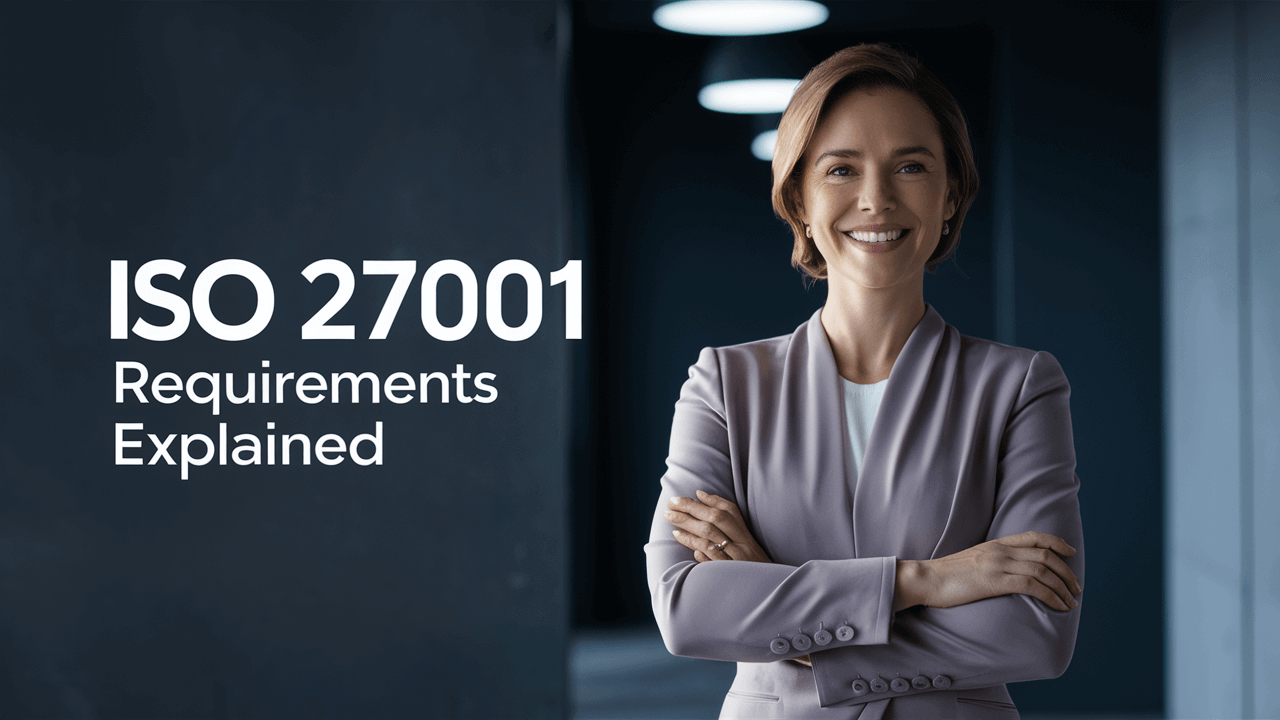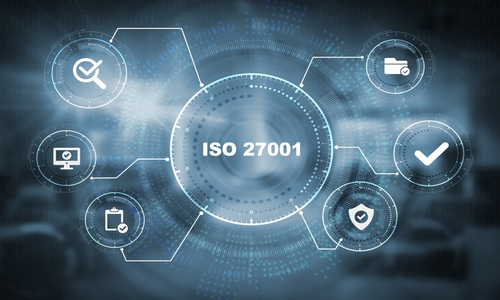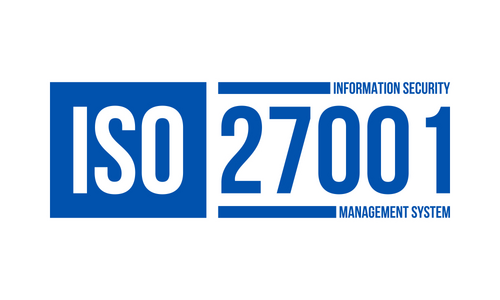Ever felt like information security is a frizzy mess of jargon, checklists, and endless meetings? You are not alone. Yet, here is a twist as ISO/IEC 27001:2022 steps in. This updated international standard for Information Security Management Systems(ISMS) aids organizations like yours in proactively managing information security risks. Whether you are seeking your first certification or transitioning from the 2013 version, glad you made it here; this blog’s got you covered. This guide walks you through everything you need to know about ISO 27001 requirements clearly and confidently.

Jump ahead to
What is ISO 27001?
ISO /IEC 27001 is the internationally recognized standard that outlines a well-structured architecture for identifying, administering, and, most importantly, reducing risks to Information Security Management Systems. The standard comprises two main pillars, which are:
- Clauses 4-10: Mandatory management system requirements
- Annex A: A structured list of 93 security controls categorized under four domains.
In fact, it’s less about tech for tech’s sake. Meanwhile, it’s more about aligning your processes, policies, and also people to safeguard the entire information ecosystem.
Understanding the ISO 27001 requirements list is the first step toward designing an ISMS that actually works for your business.
Clauses 4-10: The Core of ISO 27001
Let’s dive deeper into the clauses. These are not strict rules but living strategies you’ll implement to weave security into your organizational DNA.
Clause 4- Context of Your Organization
Before you secure data, it is crucial to understand the world your business operates in. This clause pushes you to zoom out and see the bigger picture. It marks the beginning of formal ISO 27001 requirements and sets the stage for contextualizing risks within your business environment. So that you’ll need to:
- Identify external and internal influences that affect information security.
- Understand stakeholders’ expectations
- Define your ISMS scope with precision, leaving no grey areas
It matters as it affirms that your security controls are not built in a vacuum but reflect the reality of your business.
Clause 5- Leadership
It’s time for top management to walk the talk. Information security starts at the top. Senior leadership must showcase the commitment and take ownership of ISMS. Therefore, you must:
- Assign ISMS roles and responsibilities
- Embed security into your company’s DNA via policy
- Champion continual improvement
It’s a plain truth that if leadership does not lead, the system won’t follow.
Clause -6: Planning
Here is where you put on your risk management hat. The clause requires integrating risk-based thinking into the planning process. This aids in ensuring that the objectives are consistently met.
- Identify risks and opportunities
- Determine information security objectives
- Plan how to address risks using appropriate Annex A controls
If you fail to plan, then you plan to fail. It’s a gospel truth.
Clause 7- Support
Even the best strategies fail without the right fuel, people, knowledge, and infrastructure. Furthermore, it is truly important to maintain clear external and internal communication.
- Ensure skilled personnel and proper training
- Maintain effective communication
- Keep documentation up-to-date and accessible
Clause 8- Operation
Now it’s showtime. You roll up your sleeves and execute the plan. This phase involves coordinating resources and ensuring every task lines up with the defined goals.
- Implement risk treatments
- Manage operational changes securely
- Maintain document evidence of controls and actions
It’s where all your planning hits the ground running.
Clause 9- Performance Evaluation
You can’t fix what you don’t measure. Definitely, it is paramount to monitor and evaluate how well the ISMS is performing.
- Conduct internal audits to ensure things are on track.
- Performance management reviews to evaluate ISMS performance.
- Use results to drive improvements.
Truly, Clause 9 is like your dashboard. It tells you when to speed up, slow down, or change direction.
Clause 10- Improvement
It is factual that no system is ever truly perfect. Therefore, there is always room to level up.
- Address non-conformities quickly and effectively
- Foster a culture of continuous improvement
- Make your ISMS smarter, not just safer.
This clause actually affirms your security posture stays sharp, not stagnant.
Annex A Controls- Organized and Updated
ISO 27001: 2022 organizes its 93 controls into four broad themes. This simplifies ISO 27001 requirements list. It’s noteworthy, only the controls relevant to your organization’s risks must be implemented.
Here’s how they break down:
| Theme | Example of Key Controls |
| Organizational (37 controls) | Information security policiesThreat intelligence(new)Cloud service uses security(new)ICT continuity readiness(new)Supplier relationshipsBusiness continuity planningAcceptable use of assetsSecure onboarding/offboarding |
| People (8 controls) | Background verificationSecurity awareness trainingDisciplinary proceduresRole-based access controlResponsibilities for information securitySecure remote working |
| Physical (14 controls) | Physical entry controlsAsset protectionSecure areas and facility layoutEnvironmental and disaster protectionPhysical security monitoring(new)Secure disposal of assets |
| Technological (34 controls) | Malware protectionEncryption of dataSecure system engineeringLogging and monitoringWeb filtering(new)Data masking and leakage prevention(new)Configuration management(new)Secure coding and development(new) |
Certification Criteria and Implementation Roadmap
- Define the ISMS scope- Identify assets, locations, and, moreover, departments included in your Information Management Security Systems.
- Conduct risk assessment and treatment- Evaluate risks to information assets, determine suitable Annex A controls, and most importantly, create a risk treatment plan.
- Develop policies and procedures- Establish security policies, incident response plans, and also employee awareness programs to build a security-first culture.
- Implement and monitor controls- Deploy selected controls, maintain audit trails, and use logs to monitor system effectiveness and compliance.
- Conduct an internal audit- Perform a thorough self-assessment to detect, correct non-conformities, and prepare for external scrutiny.
- Engage a certification body- Select an accredited certification body to conduct an external audit and thus become certified.
Each phase of this road map aligns directly with the ISO 27001 requirements list.
Preparing for the Transition
- It is foremost to review the updated ISO 27001:2022 requirements and structure
- It is pivotal to update your statement of applicability to reflect revised Annex A controls
- Map existing controls to updated themes
- Train staff on new requirements
- Reassess risks, considering new threat vectors and regulatory changes
- It is important to conduct a transition gap analysis and close identified gaps before your recertification audit.
2025 Deadline: Time is Ticking
It should be recalled that organizations still certified under the ISO 27001:2013 version must transition to the 2022 version by October 31st, 2025. This implies that, after this date, the old ISO 27001 certification will not be valid. Moreover, this is not just a compliance checkbox. Missing the transition window can lead to:
- Loss of contracts or partnerships
- Delays in audits and project approvals
- Gaps in security posture
- Reputational damage
Definitely, now is the time to plan and act. Book your audit early to avoid a last-minute rush.
What‘s New in ISO 27001:2022?
This version of ISO 27001 introduces some pivotal improvements. It includes:
- Controls reduced from 114 to 93 by merging duplicates and refining the content.
- 11 new controls have been added to address contemporary cybersecurity challenges like cloud usage and security development.
- The control structure is now grouped into four logical themes instead of 14 domains.
- Stronger alignment with ISO 27002 and other ISO management standards.
- Updated terminology and emphasis on real-time risk handling.
Unlike reactive approaches, ISO 27001 is proactive. It aids you in anticipating a storm before the lightning strikes.
Final Thoughts
Let’s face it, security can seem like a daunting mountain. However, with ISO 27001 as your trail map, you are not just climbing aimlessly. On the other hand, you are building a path to long-term resilience and trust. It’s true that ISO 27001 is not a one-time implementation. It’s a living system that evolves with your business, industry, and threat landscape. Hence, investing in ISO 27001 Training empowers a team with the knowledge to implement, audit, and, moreover, sustain an ISMS effectively. This training aids organizations in meeting and sustaining ISO 27001 requirements and thus builds a culture of security resilience.
Now the path is clear. You‘re well-versed in the requirements of ISO 27001. So, will you take the lead and champion security that inspires confidence?
FAQs
What is ISO 27001?
ISO 27001 is an international standard for managing information security. It provides a framework for establishing, implementing, maintaining, and continuously improving an Information Security Management System.
Why is ISO 27001 important?
ISO 27001 is paramount as it aids in protecting and ensuring sensitive information and thus builds trust with customers and stakeholders.
What are the core requirements of ISO 27001?
The key requirements of ISO 27001 are risk assessment, establishing security policies, implementing controls, internal audits, and continuous improvement.
What are the clauses in ISO 27001?
There are 10 clauses, with clauses 4 to 10 being mandatory for ISMS implementation. It covers context, leadership, planning, support, operation, performance, and improvement.
What is Annex A in ISO 27001?
Annex A lists 93 reference controls grouped under four themes. It is used to manage risks identified during the assessment.
Is ISO 27001 mandatory?
Not by law. However, many industries and clients require this standard to ensure a high level of information security.
Who can implement ISO 27001?
It can be implemented by any organization in any sector. Regardless of size, any organization can benefit from ISO 27001.
What is the difference between ISO 27001 and ISO 27002?
ISO 27001 outlines the requirements. On the other hand, ISO 27002 provides guidance on implementing the controls listed in Annex A.
What documents are needed for ISO 27001 compliance?
The important documents include the ISMS scope, risk treatment plan, Statement of Applicability, security policies, and audit logs.



